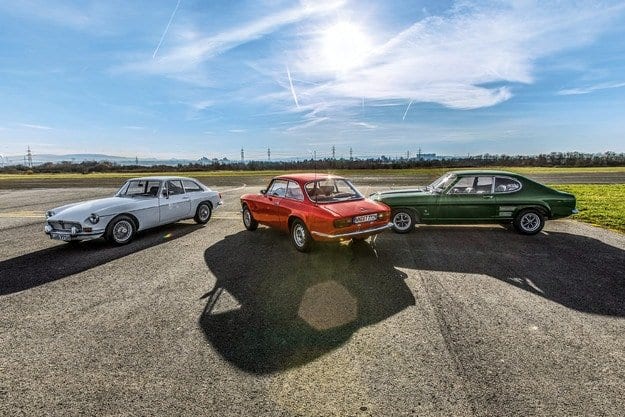
Test drive Alfa Romeo 2000 GTV, Ford Capri 2600 GT, MGB GT: 1971

Three sports coupes reflecting the automotive diversity of the 60s and 70s.
When Alfa Romeo introduced the 46 GT Veloce 2000 years ago, the Ford Capri 2600 GT and MGB GT are already set standards in sports coupes. Today we once again invited three models for a walk.
Now they are looking at each other again. They hide, still staring defiantly into each other's eyes - sorry, headlights - as they once did in the early 70s. Then, when Alfa Romeo was a company with a solid reputation in the touring car class, Ford first launched the oil car feel on German roads, and in its rainy kingdom, the people of MG implemented the advantages of a coupe body over nimble roadsters in their Model B. Even today, in our meek photo shoot, there is a sense of competition in the air. This is probably the way it should be when three sports cars meet – in this case the Alfa Romeo 2000 GT Veloce, the Ford Capri 2600 and the MGB GT.
Let's stop for a while in the 70s, or rather in 1971. Then the 2000 GT Veloce is a brand new model and costs 16 marks, while our dark green Capri I, shortly before the premiere of the second series, is sold for 490 marks. And the white MGB GT? In 10 it will cost about 950 1971 marks. You could buy three VW 15s for that amount, but as you know, the pleasure of a sports car always required additional funds - even if it is not more powerful or faster than a regular model with a decent engine. It was the MGB GT that was sharply criticized in this regard as early as 000 by automobile and sports tester Manfred Jantke: “In terms of the weight of a four-door sedan and light lifting engine, the narrow two-seat model is far inferior to sports cars. less workload and less cost.”
Here it must be said frankly that today neither the highest sports qualities nor dynamic performance play a role. Today should show something else - how different car philosophies were in northern Italy, along the Rhine and in the British Isles. And in order not to get into some kind of rating, despite this warning, the participants will be presented in alphabetical order.
Form for eternal times
So, And as Alpha. The GT Veloce 2000 is already waiting for us with a warm engine - beautiful as a picture, and at the same time an unrestored copy of 1972. But let's continue and go - no, this time we will not do this, because our eyes want to see first. Formally, the 2000 GTV was an old acquaintance – because, strictly speaking, our model differs only in a few details from the 1963 Giulia Sprint GT, the first 2+2 coupe designed by Giorgio Giugiaro in Burton.
The striking sheet metal edge that runs through the nose in front of the engine and from the very beginning gave the car the nickname "beaded front" was changed in various models between 1967 and 1970 in favor of a smooth front (with the introduction of the so-called front edge). Alfa's round bonnet also ditches the Giulia name in the sports coupe). And twin headlights adorned the previous top model, the 1750 GTV. Exterior 2000s are truly new in the chrome grille and large taillights.
But let's put our hand on our heart and ask ourselves - should anything improve at all? To this day, this exquisite coupe has literally lost nothing of its charm. That line, from the upper edges of the front fenders to the sloping rear that has always looked like a luxury yacht, still amazes you today.
GTV is an undoubted athlete
The admiration for the view continues in the interior. Here you sit deeply and comfortably, even in place you feel that they have taken care of sufficient lateral support. Immediately after that, your eye falls on the tachometer and speedometer, between which there are only two small indicators of fuel and coolant temperature, which in the previous model were located on the center console. The right hand somehow spontaneously rests on the leather-wrapped sloping shift lever, which - at least you feel - leads directly to the gearbox. With your left hand, hold the wooden wreath on the steering wheel deep in the middle. Without a doubt, this is a sports car.
When we fire up the GTV engine, the powerful, resonant roar of Alfa Romeo’s largest all-alloy four-cylinder unit to date immediately stirs up a thirst for ownership – not least because you know it comes from 30 Grand Prix engines in its basic design. -s. But despite the fact that many praises have been sung for this twin-cam engine, the author of these lines can do nothing but emphasize once again how impressive this two-liter unit with 131 hp is.
The long-travel car spontaneously reacts to every accelerator pedal movement, has an amazing intermediate thrust and at the same time, as speed increases, it sounds as eager to attack as we know from racing cars. It is quite clear that with this wheel you will always be a little faster than you actually need.
The chassis inherited from Julia perfectly matches the GTV character. The turns are not at all intimidating to the light coupe, and the course change, of course, is done as a joke when there are only two fingers on the steering wheel. And if in the worst case all four wheels with disc brakes can skid at the same time, a small adjustment with the steering wheel is enough. Few cars are as easy to drive as the Alfa Romeo 2000 GT Veloce.
Low price, impressive appearance
But what if we crave more power, but our money is not enough for a relatively expensive Alfa GTV? In many cases the answer was: Ford Capri 2600 GT. Its low price was the strongest argument in favor of this sporty model for the whole family - of course, along with great looks. Compared to the bodywork of Bertone, the dark green 2600 GT XL from the collection of Capri specialist Thilo Rögelein plays a macho role, as it has a wider and more muscular figure, and with a long torpedo and a short butt, it has classic athletic proportions. car. The relationship with the American Ford Mustang cannot be denied regardless of the angle (although the roots of the model go back to England and it was based not on the Falcon, as in the Mustang, but on the Ford Cortina). From the large American model came an expressive crease in front of the rear wheels, in which two decorative grilles are built. Yes, Capri lives by its form. And its absolute recognition.
This quality could be further improved with a nearly endless list of additional items and accessories that worked very well with the Mustang. In the immediate aftermath of the Capri's debut in January 1969, buyers were able to choose between five equipment packages and, by ordering a few gadgets, transform their car into something like a factory unique.
Prefabricated vehicle
On the other hand, technically the Capri is pretty straightforward. The model has neither brilliantly designed engines nor a complex chassis, but remains a massive vehicle made from standard Ford components, including a rigid leaf-sprung rear axle and cast-iron engines. Initially, however, the choice included three V4 engines from the 12M / 15M P6 models - 1300, 1500 and 1700 cc. Six-cylinder V-units were available from 1969, initially in 2,0 and 2,3 inch displacements. , 1970 liters; vehicles equipped with them can be recognized by the hood protrusion. This, of course, adorns our model with a 2,6 hp 125-liter unit produced since XNUMX.
In addition, the GT XL version is furnished quite elegantly. The instrument panel has a woodgrain pattern and, along with the speedometer and tachometer, there are four smaller round instruments for measuring oil pressure, coolant temperature, fuel level in the tank and battery charge. Below, on the veneered center console, is a clock, and a short shift lever protrudes - as in Alfa - from a leather clutch.
The coarse gray cast iron assembly accelerates a lot from low revs and seems to thrive best between three and four thousand rpm. Carefree driving without frequent gear changes pleases this quiet and quiet unit more than a fast pace. As a matter of fact, this is not a real V6, but a boxing technique, because each rod is connected to its own crankshaft journal.
The pleasure this car delivers to its driver is unevenly overshadowed by the very light travel of the shock absorbers. Where the Alfa follows the direction calmly, the Capri bounces to the side with its simply tailored rigid leaf-spring axle. It’s not so bad, but it’s quite tangible. In a major test of Capri in a car and sports car, Hans-Hartmut Münch recommended gas shock absorbers as early as 1970 to continuously improve road behavior.
And so we come to the MGB GT, a 1969 set that makes you feel years behind than when you're sitting in an Alfa or Ford. The posh fastback coupe designed by Pininfarina was introduced in 1965, but its design is based on the MGB that appeared two years earlier. Our model immediately shows the changes that MG has made to the technical essence of their bestseller over the 15-year period of production - almost no changes. Isn't this a rebuke to the white 1969 MGB GT Mk II? Exactly the opposite. “It's this pure and genuine driving feeling that makes every drive with this car a real pleasure,” says owner Sven von Bötticher from Stuttgart.
Dashboard with airbags
The dashboard with classic, beautiful round instruments and a three-spoke perforated steering wheel show that this GT is a made-for-US model. In response to MG's new safety laws, they built into the roadster, as well as the interior, a massive upholstered instrument panel, nicknamed the "Abingdon cushion".
The British Motor Corporation cast-iron 1,8-litre four-cylinder unit with lower camshaft and lift rods sounds rougher and raspier at idle than the engines of the other two participants in the meeting. With ninety-five confident horses and all the torque you need just above idle, the excellent manner in which this noisy machine does its job is admirable from the first meter. Which of course has to do with the gearbox. With a short joystick lever that comes out of the gearbox itself. Is it possible to have a switch shorter and drier? Maybe, but it's hard to imagine.
The first impression when we hit the road is that the rigid rear axle transmits any bumps to the cab unfiltered. The fact that this Englishman is still firmly tied to the asphalt is a real revelation. However, fast maneuvers on the road require strength, like the rudder of a three-masted ship. And your right leg needs to be well trained to get some braking effect. Driving in a very simple way - some call it quintessentially British. In any case, the MGB GT is an effective cure for automotive boredom, a discipline that Alfa and Ford models have also mastered almost to perfection.
Conclusion
Editor Michael Schroeder: An Italian thoroughbred sportsman, a German oil car and a British good-natured thug - the difference really couldn't be greater. As a road speaker, I would like the Alfa model the most. However, I fell in love with the powerful versions of the Capri a long time ago, and the refined MGB GT has somehow eluded me until now. Today it became clear that it was a mistake.
Text: Michael Schroeder
Photo: Uli Ûs
technical details
| Alfa Romeo 2000 GT Veloce | Ford Capri 2600 GT | MGB GT Mk II | |
|---|---|---|---|
| Working volume | 1962 cc | 2551 cc | 1789 cc |
| Power | 131 k.s. (96kW) at 5500 rpm | 125 k.s. (92 kW) at 5000 rpm | 95 k.s. (70 kW) at 5500 rpm |
| Maximum torque | 181,5 Nm at 3500 rpm 181,5 | 200 Nm at 3000 rpm | 149 Nm at 3000 rpm |
| Acceleration 0-100 km / h | 9,0 with | 9,8 with | 13,9 with |
| Braking distances at a speed of 100 km / h | no data | no data | no data |
| full speed | 200 km / h | 190 km / h | 170 km / h |
| Average consumption fuel in the test | 12–14 l / 100 km | 12 l / 100 km | 9,6 l / 100 km |
| Base Price | 16 marks (in Germany, 490) | 10 marks (in Germany, 950) | 15 marks (in Germany, 000) |

